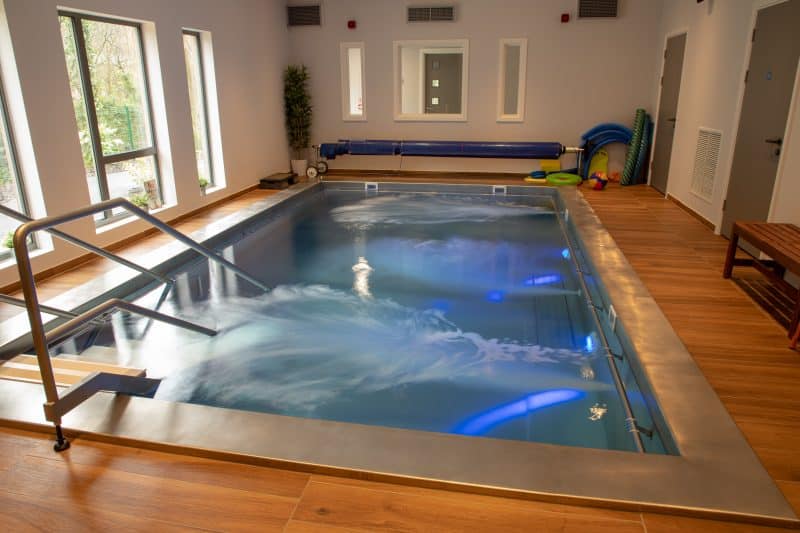The medicinal and therapeutic properties of water have been celebrated for centuries. Being in water brings with it an array of both physical and mental benefits, which is why our hydrotherapy pool and aquatic therapy sessions are much loved by clients. In this article, we explain the benefits of aquatic therapy and share the experience of one of our clients.
What is aquatic therapy?
Aquatic physiotherapy is a therapy programme that utilises the properties of water to help an individual to maximise function, which can be physical, physiological or psychological. The programme is designed by a specialist qualified physiotherapist and delivered by appropriately trained personnel, ideally in a purpose built, and suitably heated hydrotherapy pool.
Why aquatic therapy?
Water helps the body feel weightless and supports buoyancy whilst providing resistance to movement, making it a perfect medium for rehabilitation. Water exercises can help with the re-education of functional activities and improve balance, coordination, and posture. It improves muscle tone, range of motion, joint flexibility and delivers a natural pain relief by reducing muscle spasms.
Below is a table setting out the benefits of aquatic therapy:
Case Study – use of aquatic physiotherapy in spinal cord rehabilitation
‘Sally’, aged 18, fell from a balcony and sustained an incomplete spinal cord injury and as a result, underwent surgery.
For three years she received intermittent physiotherapy and hydrotherapy in her country of residence but decided to seek treatment in the UK as she wanted to see if she could improve her mobility. She was using a wheelchair for long distances and could mobilise on 2 elbow crutches for short distance when wearing ankle supports. Her long -term goal was to be able to mobilise independently.
Objective assessment
On land Sally was unable to stand independently and her balance was poor. She suffered from decreased joint mobility and muscle strength, altered motor control and emotional factors including fear and anxiety.
She had normal sensation in both legs to her knees, but below this she was unable to detect pain or temperature.
Aquatic therapy treatment and rehabilitation
Sally had 2 aquatic therapy sessions per week for 16 weeks in the hydrotherapy pool at STEPS Rehabilitation on a 1:1 basis, these complemented land-based sessions. The focus of these sessions being to; provide a safe environment to challenge her balance, stability and stamina. During the sessions, Sally used the properties of the water to gain more independent movement, gradually increasing strength throughout range and to allow weight bearing/mobilisation.
Each aquatic therapy session lasted 20 minutes initially, building up to 30-40 minutes as tolerated.
Below are descriptions of some of the movements and techniques her aquatic physiotherapist used in her sessions.:
- Sea-weeding; in supine (lying face upwards), gentle movements through the water by therapist to aid in relaxation and create some gentle movement.
- Supine float, anchored in the corner of the pool, holding onto bar, utilising drag and increasing speed to add resistance.
- In above position; hip extension, water adding resistance to increase strength by pushing against the weight of water.
- Water cycling on woggle: aided in core strength, pelvic balance, cardiovascular fitness and coordination, with the legs working against the resistance of the water.
- Holding onto the bar, forwards walking and side-stepping encouraging weight transference onto the left.
- Walking forwards holding onto float in front; encouraging Sally to bring weight forwards and decrease retraction of shoulders.
- Walking independently forwards, backwards and side stepping.
A keen swimmer before her accident, it was particularly important for Sally to swim again. Using a supine float in the corner of the hydrotherapy pool; we were able to assist breaststroke legs until she progressed to doing this independently.
Outcomes after aquatic physiotherapy
Aquatic therapy provided a safe environment to challenge Sally’s balance, confidence and address her pain through its various properties. The thermal properties of the water promoted relaxation, decreasing some of the over-activity causing Sally her pain. The reduction in pain allowed the exploration of movement and weight bearing.
Sally had reduced sensation in her lower limbs and the hydrostatic pressure in the water, and also the viscosity provided sensory stimulation and a feeling of ‘security’.
Mobilising in the water also facilitated an increase in quality of movement.
Ultimately, Sally achieved her goal of mobilising with 1 crutch (and foot supports) her pain was reduced and muscle strength in Glutes, Hamstrings and Quadriceps gained.
We offer aquatic therapy as part of a rehabilitation programme. To find out more, please call 0114 258 7769 or email: hello@stepsrehabilitation.co.uk.
